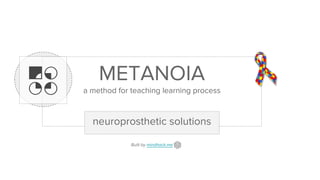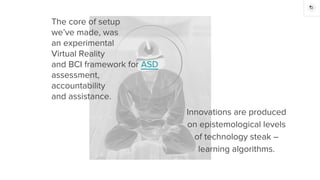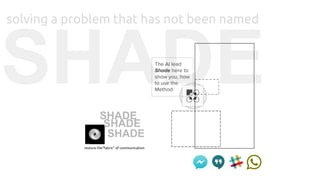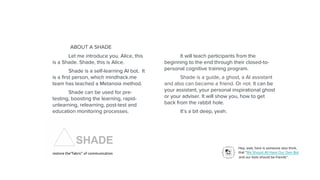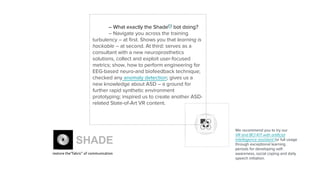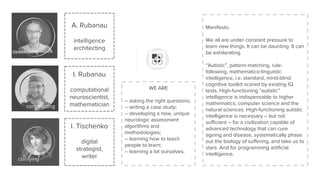metanoia presentation
- 1. METANOIA a method for teaching learning process neuroprosthetic solutions Built by mindhack.me
- 2. You want to learn, but you canât. People (you suspect they are very, very stupid) didnât know, how your brain works and how to teach you to recognize your patterns. The life at planet surface (the usual way people do it) is too simple and so, invisible for you. Most of time you even donât recognize the short-viewed signs and signals which people transfers to each one and (probably) for you, but that did not confirmed. Thatâs why you canât learn. No one knows, how to teach you and even donât know, where to look at answer. They didnât get and maybe never will get, whatâs going at your head. Thatâs why no one can teach you. You have bigger source sequences for neurons predictions and zero methods to understand the void you are in. Your patterns is too difficult to recognize (for usual people itâs unavailable at all), and youâre right â people too stupid to understand you. ASD. Puzzle-kid. Fractale-shaped non-understandable complicated strange world outside balanced with inner rabbit hole. It means, your schedule and your rules is a supremacy law, not a topic to discussion, and the law means for you more thanâĶ more, than. Common conventionalities are not conventionalities at all â rules here are overcome concepts.
- 3. The core of setup weâve made, was an experimental Virtual Reality and BCI framework for ASD assessment, accountability and assistance. Innovations are produced on epistemological levels of technology steak â learning algorithms.
- 4. Metanoia is an Ancient Greek word (ΞÎĩÏÎŽÎ―ÎŋÎđÎą) meaning "changing one's mind". Metanoia is an algorithm, proceed a âlearning how to learnâ human process. Metanoia has been created by a scientific research team, last years focused on neuroscience field, especially for kids with ASD, which mental condition usually strongly connected to a learning disability. Taking advantage at different emerging Brain-Computer Interfaces (BCI), wearable sensors and virtual reality features, a cognitive control trainings methodology based on Sequence Memory Theory (SMT) was developed. ABOUT THE METANOIA IDEA
- 5. Metanoia concept based on a new data interpretation at computational neuroscience field. Shortly: underconnectivity can be learning barrier. For monitoring we propose To Go/ Not-to-Go Test, The Working Memory Test, and The Flanker Task. They reveal each participantâs measurable growth, individualized results and next steps for kids, to show what else they are capable to learn in the future â and the way we could help. Participant (or a person, close to participant) can analyze the success of the program with the real-time data to back up every step of the way. To Go/ Not- to-Go Test The Working Memory Test The Flanker Task
- 6. Metanoia cognitive assessmentâ method designed to boost and measure cognitive growth. Correct usage of personalised combination of approaches are utilized ASD visual specialities, enhanced pattern recognition and prevalent rules under concepts. Yes, here are proofs. The key principles for assessments are providing focus prolongation, positive & negative reinforcement (both high-graded and relevant) and encapsulating metaprocess through classes, all to provide 4-6 hours heavy loaded learning periods 2-3 time in week. Metanoia is a method, but also is a journey.
- 7. SHADE solving a problem that has not been named The AI lead Shade here to show you, how to use the Method. SHADE restore theâfabricâ of communication SHADE SHADE
- 8. Hey, wait, here is someone also think, that âWe Should All Have Our Own Bot and our bots should be friendsâ. Let me introduce you. Alice, this is a Shade. Shade, this is Alice. Shade is a self-learning AI bot. It is a first person, which mindhack.me team has teached a Metanoia method. Shade can be used for pre- testing, boosting the learning, rapid- unlearning, relearning, post-test and education monitoring processes. ABOUT A SHADE It will teach participants from the beginning to the end through their closed-to- personal cognitive training program. Shade is a guide, a ghost, a AI assistant and also can became a friend. Or not. It can be your assistant, your personal inspirational ghost or your adviser. It will show you, how to get back from the rabbit hole. Itâs a bit deep, yeah. SHADE restore theâfabricâ of communication
- 9. â What exactly the Shade(5) bot doing? â Navigate you across the training turbulency â at first. Shows you that learning is hackable â at second. At third: serves as a consultant with a new neuroprosthetics solutions, collect and exploit user-focused metrics; show, how to perform engineering for EEG-based neuro-and biofeedback technique; checked any anomaly detection; gives us a new knowledge about ASD â a ground for further rapid synthetic environment prototyping; inspired us to create another ASD- related State-of-Art VR content. We recommend you to try our VR and BCI KIT with artificial intellegence assistant for full usage through exceptional learning periods for developing self- awareness, social coping and daily speech initiation. SHADE restore theâfabricâ of communication
- 10. A. Rubanau intelligence architecting I. Rubanau computational neuroscientist, mathematician I. Tischenko digital strategist, writerclarifying constructing developing Manifesto. We all are under constant pressure to learn new things. It can be daunting. It can be exhilarating. âAutisticâ, pattern-matching, rule- following, mathematico-linguistic intelligence, i.e. standard, mind-blind cognitive toolkit scored by existing IQ tests. High-functioning âautisticâ intelligence is indispensable to higher mathematics, computer science and the natural sciences. High-functioning autistic intelligence is necessary â but not sufficient â for a civilization capable of advanced technology that can cure ageing and disease, systematically phase out the biology of suffering, and take us to stars. And for programming artificial intelligence. WE ARE â asking the right questions; â writing a case study; â developing a new, unique neurologic assessment algorithms and methodologies; â learning how to teach people to learn; â learning a lot ourselves.

